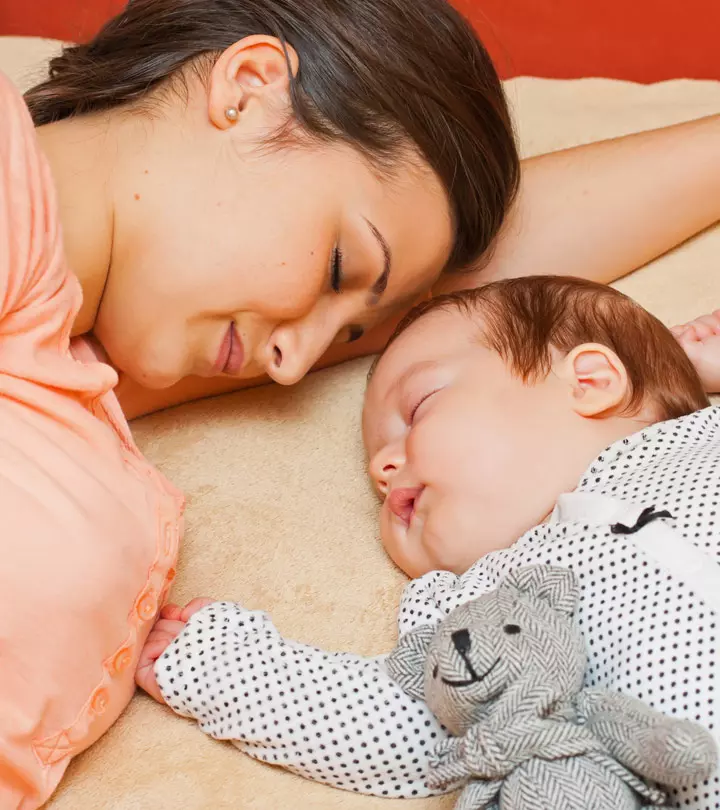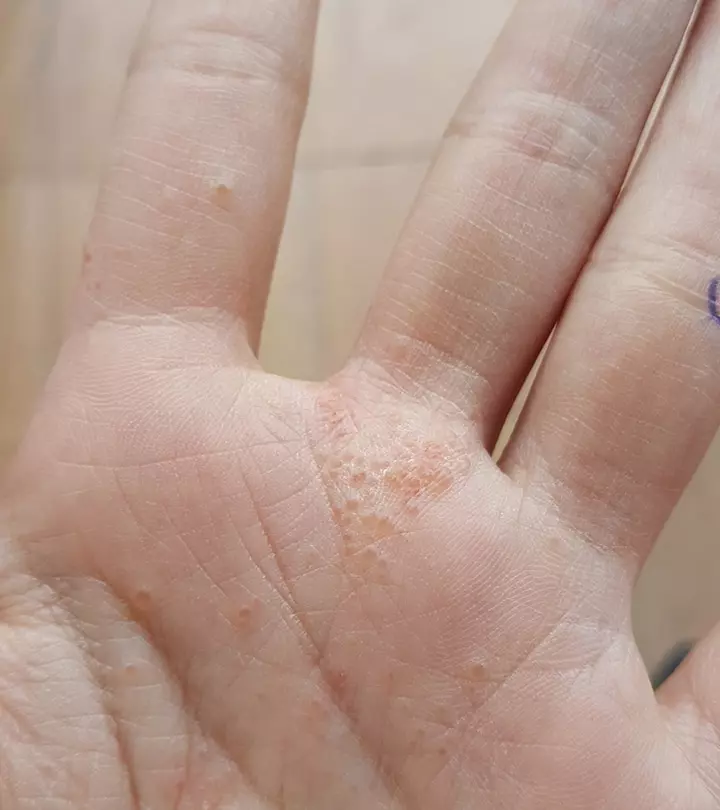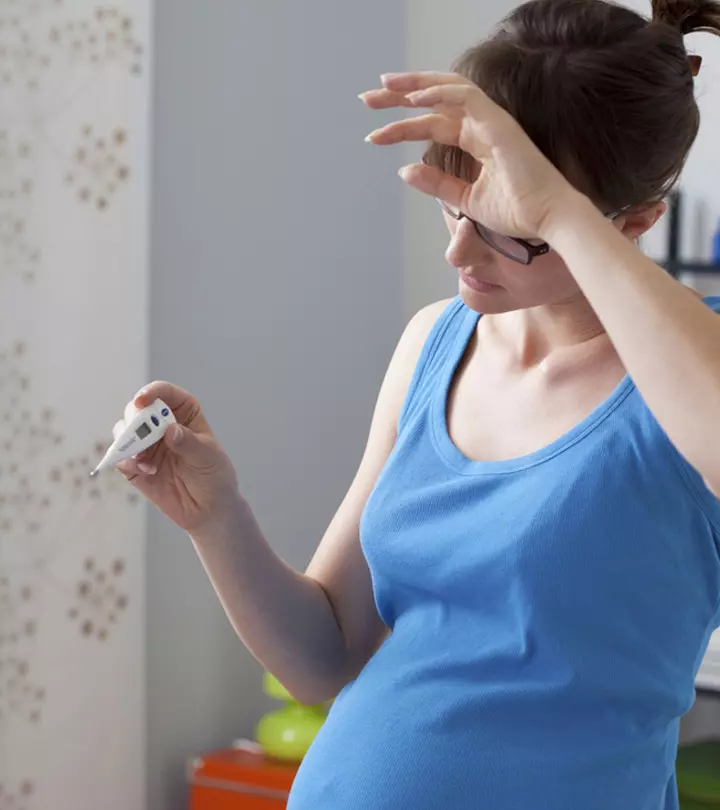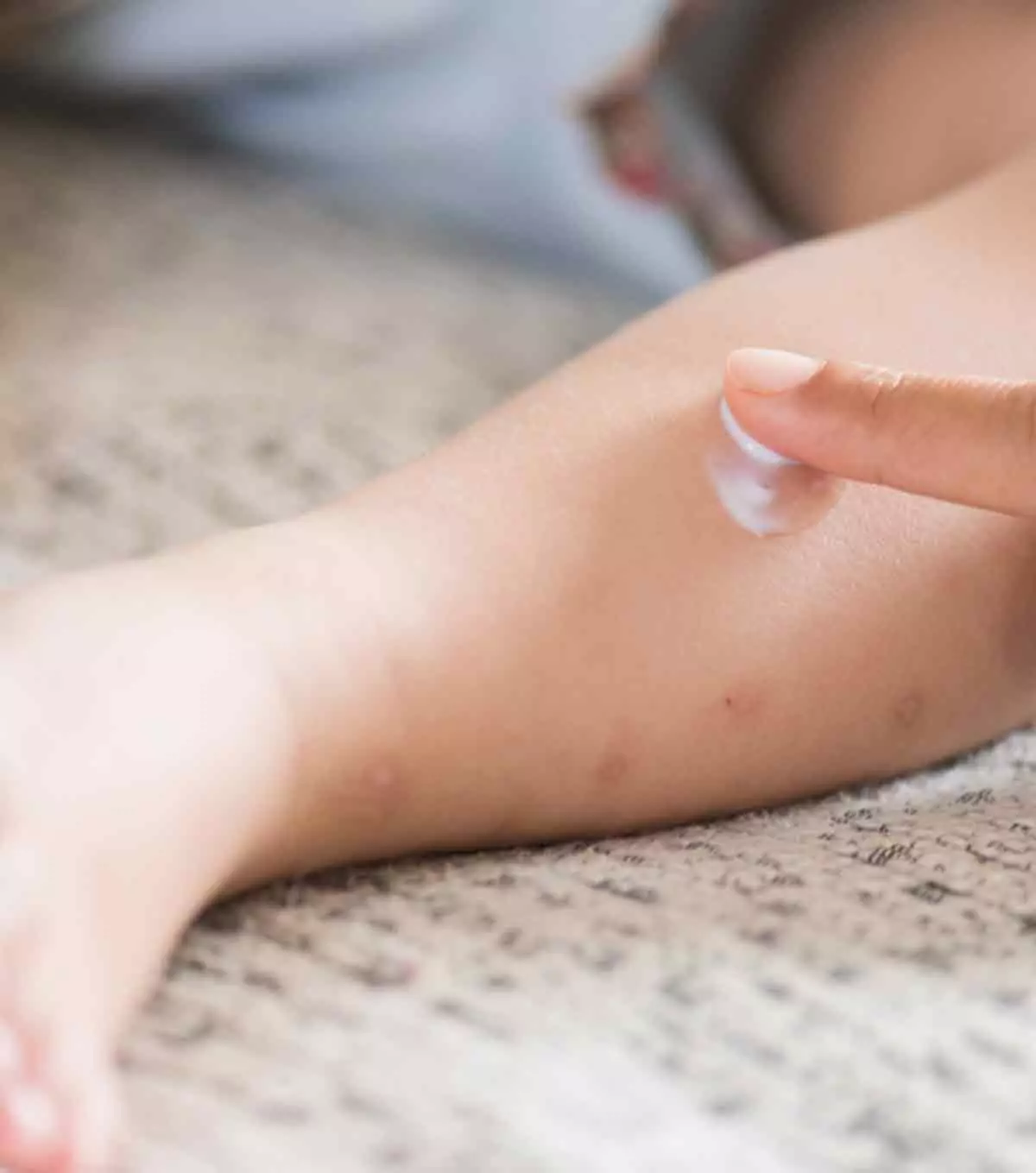
Image: Shutterstock
Calamine lotion is a popular skin lotion used across all age groups. But should you use Calamine lotion for babies? We explore this question in this post. The topical lotion with anti-itch and cooling properties has been an over-the-counter medicine for decades. It is a widely used skin care product for relieving symptoms of several skin ailments (1). Many parents turn to calamine lotion to manage simple skin problems in infants. However, before applying the lotion, consult a pediatrician to learn about its safety and appropriateness for your baby’s delicate skin. Read this post to know the safety, potential uses, possible side effects, and precautionary measures for using calamine lotion in babies.
Key Pointers
- Calamine lotion may be used to treat heat rashes, pruritis, sunburns, insect bites, etc., in babies.
- Skin redness, rashes, hives, and pus discharge are a few possible side effects of calamine lotion.
- Stop using the lotion if any rashes appear on the baby’s body.
Is Calamine Lotion Safe For Babies?
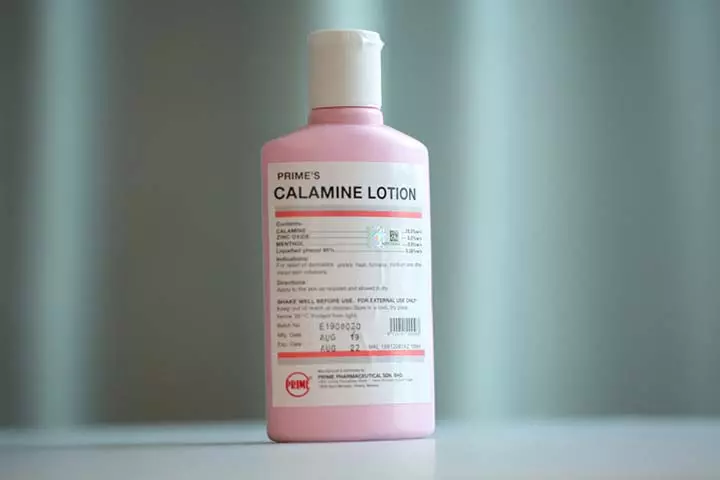
Calamine is a mild and gentle lotion that can be safely used for relief from skin irritation and other skin problems in babies (2). The lotion also has astringentiA property of a substance that helps in removing excess oils and tightening pores properties, which constrict skin tissue to help provide the baby relief from skin inflammation.
Although calamine lotion is considered baby-friendly, it is vital to consult the pediatrician before use. Calamine products containing phenol should be avoided in infants, as phenol can harm their delicate skin (2).
Uses Of Calamine Lotion For Infants
The following are the possible conditions where calamine lotion might be useful. However, do not use them without consulting the doctor.
1. Oily skin
Applying calamine lotions on newborns helps manage excessively oily skin owing to its mild drying action on the skin and yet moisturizes the skin.
2. Pruritus
Pruritus is skin itchiness, which might be localized or generalized. It might happen due to skin reactions or due to systemic disorders. Calamine lotion helps in reducing itchiness owing to its cooling or skin-soothing effect (3).
3. Heat rash
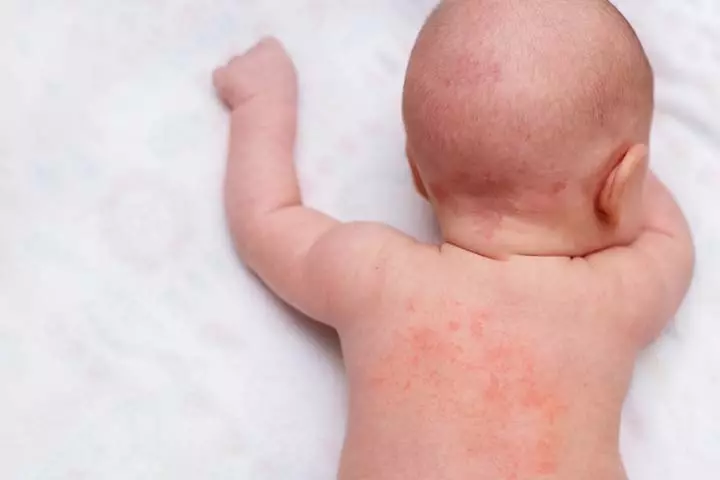
Heat rash is characterized by fine, pink-colored skin rashes caused due to overheating. Calamine lotion has a cooling effect on the skin and helps relieve the prickly feeling (4).
4. Sunburn
It helps heal the skin irritated by sunburns (5).
5. Poison ivy, poison oak, and sumac
The US Food and Drug Administration (FDA) advises applying calamine lotion to soothe itching and irritation from poison ivy, poison oak, and poison sumac (6). All these plants release an oily sap containing a compound called urushiol, which on contact with skin causes severe itchy rashes and blistersiPainful swelling (or bubble) on the skin's outer layer, containing fluid-filled cavities . Though babies may not directly come in contact with poison ivy, adults, older children or even pets may sometimes become the carriers. Calamine lotion could help soothe skin affected by urushiol (7).
6. Miliaria
Miliaria is a severe form of heat rash and is often seen on skin folds and parts of the head, neck, and upper chest. It is caused due to blocked sweat glands. Calamine lotion can help provide relief from miliaria (8).
7. Insect bite
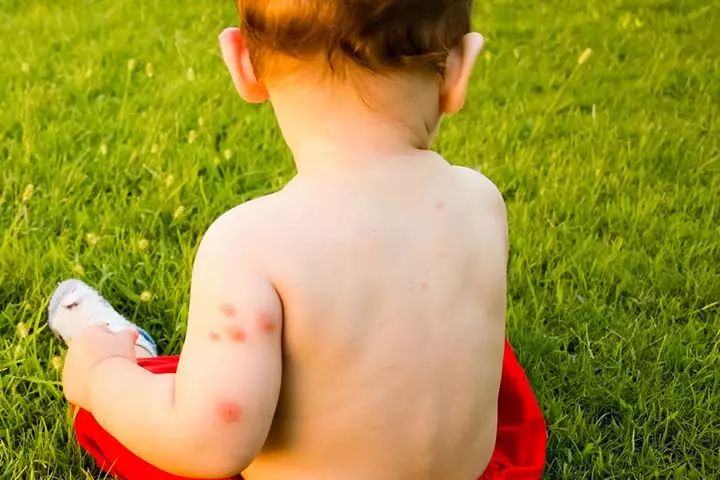
Calamine lotion helps soothe and coat the skin that is irritated due to insect bites, such as bug bites or flea bites on babies (9).
8. Chickenpox blisters
Chickenpox blisters not only cause itching and discomfort, but they may stay even after the illness is gone. The Centers for Disease Control and Prevention (CDC) recommends using calamine lotion to help ease chickenpox symptoms (10). The topical application of calamine lotion clears chickenpox blisters and provides relief (11).
9. Scabies
Scabies causes intense itchiness and skin irritation due to rashes. Calamine lotion can be used to reduce itchiness (12).
10. Eczema
According to the Centers for Disease Control and Prevention, the incidence of eczema among children aged zero to five is estimated to be 10.4% (13). Zinc is a component of calamine lotion and could help relieve baby eczemaiA common skin condition characterized by itchy, red, and dry skin , which is also known as atopic dermatitis (14). Therefore, applying calamine lotion can help administer zinc oxide for babies with eczema.
11. Hives
Hives cause severe skin irritation, redness, and itching, often triggered by allergies, stress, or environmental factors (15). Calamine lotion can be applied to provide temporary relief from the itchiness caused by hives (16).
12. Psoriasis
US Food and Drug Administration (FDA) recommends calamine lotion to treat itchiness caused by psoriasisiA chronic, proliferative, inflammatory skin disease that causes skin dryness and itchiness (17).
13. Shingles
The blisters caused by shingles burn and are painful. They might also crack open and bleed. Calamine lotion acts as an itch medication for irritated skin (18).
14. Hand, foot, and mouth disease
Babies affected by hand, foot, and mouth disease develop itchy blisters all over their bodies. Calamine lotion can help in imparting coolness to the skin and reduce itchiness (19).
15. General skin irritation
Calamine lotion can be useful for relief from general skin irritation. A study evaluated the effect of calamine lotion in reducing skin irritation in children with cast immobilization and examined factors related to skin irritation. As per the report, “Children in the calamine group were less likely to develop skin lesions, had less itch during casting, had a greater decrease in the itch level, and had lower sweat levels (20).”
Some people use calamine lotion for the treatment and management of cradle caps and diaper rash in babies. However, there is not enough medical evidence to substantiate its use. Seek medical help if you see a skin rash worsening or increasing in number.
Due to the presence of zinc oxide, Calamine can also be used as a sunscreen (2). As it is primarily a dermatologist-recommended lotion for adults, it is crucial to seek a pediatrician’s consent before using it on babies. Also, sufficient studies are lacking to confirm its skin healing and skin-protectant benefits for infants.
 Quick tip
Quick tipHow To Use Calamine Lotion For Babies?
Consider the following points while using calamine lotion for your baby (7).
- Read all the drug information on the label carefully.
- Shake the bottle of calamine lotion well before use.
- Wash and dry the affected area before applying the lotion each time.
- You can perform a patch test on a small area of the baby’s skin before full application to check for any allergic reactions.
- Use a cotton ball, face cloth, or pad to apply a thin film of the lotion evenly.
- Allow the medicine to dry up. You may put mittens on the baby’s hands to avoid them from rubbing the lotion off.
- Apply a generous amount of lotion on the affected skin two to three times daily.
- If irritation or worsening of symptoms occurs, discontinue use and consult a doctor.
- If you miss a dose, apply as soon as you remember or apply the next scheduled dose.
- Avoid applying the lotion near the eyes, mouth, or open wounds.
- Store the bottle in a cool, dry place away from direct sunlight.
- Unless a doctor advises, do not use calamine lotion on severely irritated or broken skin.
 Quick fact
Quick factThe doctor will tell you about the quantity of calamine lotion that you need to apply to your baby. Follow all the instructions stated by the doctor, including the time to apply the lotion.
Possible Side Effects Of Calamine Lotion For Babies

Calamine lotion is a commonly used agent and is usually well-tolerated by babies. However, you should discontinue its use and contact a doctor if the baby displays the following skin signs after the use of calamine lotion (1).
- Redness
- Rash
- Pus discharge
- Hives
- Difficulty in breathing
- Swelling of your face, lips, tongue, or throat.
If the lotion contains resorcinol, it should not be applied to more than 25% of an infant’s skin (2). Always keep the bottle of lotion out of the baby’s reach. Do not panic if your baby accidentally ingests calamine lotion. Wipe the baby’s mouth gently and offer them some water to drink if they have accidentally licked a bit of the lotion. Ingestion of calamine might cause minor symptoms, such as nausea, vomiting, or diarrhea (21). However, if the baby has consumed a large quantity or symptoms persist, then promptly take your baby to the doctor.
 Be watchful
Be watchfulPrecautions To Take While Using Calamine

Calamine is usually safe to use. However, take the following precautions to avoid any side effects of calamine lotion (7).
- Do not use calamine without consulting the doctor
- It is for external use only
- Keep it away from eyes, nose, mouth, genitals, and mucus membranes
- Do not apply on severely injured skin, open wounds, or oozing wounds
- Always check for the product expiry date before use
- Do a small skin patch test before applying the lotion generously to the entire body
- Discontinue the use of lotion if the rash appears
- Always keep it away from the child’s reach
- Follow the instructions on the label
Calamine may not be commonly included in the typical range of baby skincare products, so it is advisable to be cautious when considering its application on your baby’s delicate skin.
Frequently Asked Questions
1. Is calamine lotion poisonous to babies?
No, calamine lotion is not poisonous to babies as all of its contents are non-toxic, including zinc oxide. In case of accidental ingestion, they may develop an upset stomach, but it usually self-resolves (22).
2. Can I put calamine lotion on my baby’s face?
Yes, you can put calamine lotion on a baby’s face as directed by your doctor. However, ensure it does not enter their eyes, nostrils, ears, or mouth.
3. How quickly does calamine lotion work to relieve itching and irritation in babies?
Calamine lotion may provide immediate relief upon application. However, the exact time it takes for the lotion to take effect may vary depending on the individual baby and the severity of the symptoms.
4. Is it okay to use calamine lotion in combination with other baby skincare products?
It is advisable to consult with a healthcare professional or pediatrician before using multiple products simultaneously to ensure compatibility and effectiveness.
5. What are some alternative remedies to calamine lotion for treating skin irritation in babies?
Alternative remedies for treating skin irritation in babies include oatmeal baths, petroleum jelly, cool compresses, and hypoallergenic moisturizers (23). These options can help soothe and moisturize the skin, providing relief from irritation. However, it’s recommended to consult with a healthcare professional before trying any alternative remedies for your baby.
6. Is calamine lotion a natural or chemical-based product, and is it safe for long-term use on a baby’s skin?
While the main ingredients of calamine lotion are derived from natural sources, some chemical ingredients and processes may be involved to create the final product. It is generally safe for short-term use on a baby’s skin to relieve mild itching and irritation. It is recommended to discontinue its use, if the condition has not improved within a week (3). However, long-term use should be discussed with a healthcare professional.
7. Is calamine lotion safe for newborn babies?
Calamine lotion is considered safe for use in children older than two years of age (3). It is advisable to seek guidance from your child’s healthcare provider regarding the appropriate use of calamine lotion for babies younger than two years old. They can provide specific recommendations and ensure the safety and suitability of the product for your newborn.
8. Are there any known drug interactions or contraindications when using calamine lotion on a baby?
Calamine lotion is generally safe to use, but it is essential to consult with a healthcare professional or pharmacist regarding any potential drug interactions or contraindications, especially if the baby is using other medications or has underlying health conditions.The inactive ingredients in calamine lotion may cause allergic reactions or other issues, so it is important to discuss any known allergies with your healthcare provider (3).
9. How do I properly store calamine lotion to ensure it stays effective and safe for my baby to use?
To ensure the effectiveness and safety of calamine lotion, it is important to store it according to the manufacturer’s instructions. Typically, calamine lotion should be stored in a cool, dry place, away from direct sunlight and extreme temperatures. Always check the label or packaging for specific storage instructions.
10. How often can I apply calamine lotion to my baby’s skin?
Calamine lotion can be applied to your baby’s skin daily. However, consult a pediatrician to know how frequently you can use Calamine lotion on your baby’s skin based on their skin condition.
You will find calamine lotion in almost every household as it has a soothing effect on itchy and irritated skin. It effectively improves oily skin and relieves itchiness, sunburn, prickly heat, and other rashes and blisters. Using calamine lotion for babies is usually considered safe for various skin problems. However, it is best to use it after consulting a doctor since babies have soft and sensitive skin. Avoid usage if you observe blood or pus from the rashes or suspect the skin problem to be an allergic reaction.
Infographic: Do All Calamine Lotions Have The Same Ingredients?
Calamine lotion of all brands has a standard set of ingredients. However, some may have additional ingredients that may not be suitable for a baby’s skin. The infographic below explains the activity of the basic or general ingredients in calamine lotion and lists those that may not be suitable for babies. Illustration: Momjunction Design Team
Illustration: Calamine Lotion for Babies: Uses Safety And Side Effects
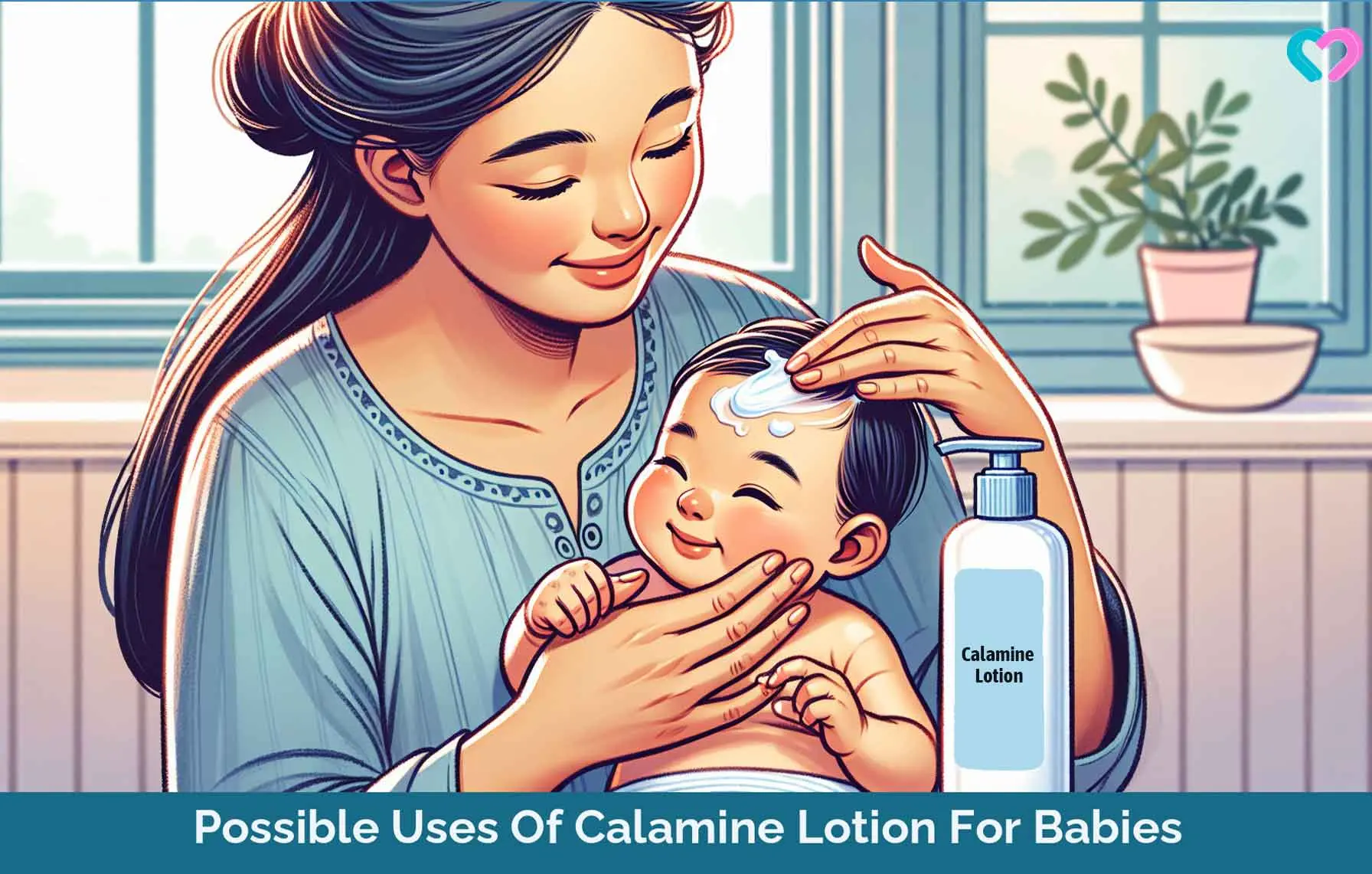
Image: Dall·E/MomJunction Design Team
References
- Calamine (topical).
https://www.mottchildren.org/health-library/d03653a1 - Nirma Joy; (2022); Calamine lotion.
https://jsstd.org/calamine-lotion/ - Calamine Lotion.
https://my.clevelandclinic.org/health/drugs/23338-calamine-lotion - Heat Rash.
https://www.seattlechildrens.org/conditions/a-z/heat-rash/ - Calamine Lotion BP.
https://www.medicines.org.uk/emc/product/4822/smpc#gref - Outsmarting Poison Ivy and Other Poisonous Plants.
https://www.fda.gov/consumers/consumer-updates/outsmarting-poison-ivy-and-other-poisonous-plants - CALAMINE.
https://dailymed.nlm.nih.gov/dailymed/fda/fdaDrugXsl.cfm?setid=6050b319-9902-333d-e053-2a91aa0ad1f3&type=display - Miliaria.
https://dermnetnz.org/topics/miliaria#:~:text=Heat%20rash%20may%20require%20medicalMild%20topical%20steroids - Insect bite first aid and prevention.
https://uihc.org/health-topics/insect-bite-first-aid-and-prevention - How to Treat Chickenpox.
https://www.cdc.gov/chickenpox/treatment/index.html - Chickenpox.
https://www.stanfordchildrens.org/en/topic/default?id=chickenpox-90-P01890 - Neonatal rash A case study.
https://www.racgp.org.au/afp/2012/september/neonatal-rash/ - Diagnosed Allergic Conditions in Children Aged 0–17 Years: United States 2021.
https://www.cdc.gov/nchs/products/databriefs/db459.htm#:~:text=In%202021%2C%2027.2%25%20of%20alland%20food%20allergies%20(5.8%25). - Mrinal Gupta et.al; (); Zinc Therapy in Dermatology: A Review.
https://pmc.ncbi.nlm.nih.gov/articles/PMC4120804/ - 10 ways to get relief from chronic hives.
https://www.aad.org/public/diseases/a-z/hives-chronic-relief - Hives: Diagnosis and treatment.
https://www.aad.org/public/diseases/a-z/hives-treatment - Over-the-Counter Topicals
https://www.psoriasis.org/over-the-counter/ - Shingles: Tips for managing.
https://www.aad.org/public/diseases/a-z/shingles-self-care - Roopashri-Rajesh Kashyap and Rajesh-Shanker Kashyap;(2015); Hand foot and mouth disease – a short case report.
https://pmc.ncbi.nlm.nih.gov/articles/PMC4483348/ - May Fong Mak et.al; (2013); Calamine Lotion to Reduce Skin Irritation in Children with Cast Immobilisation.
https://journals.sagepub.com/doi/abs/10.1177/230949901302100222 - Calamine Lotion.
https://missouripoisoncenter.org/is-this-a-poison/calamine-lotion/ - Calamine Lotion.
https://www.chop.edu/centers-programs/poison-control-center/calamine-lotion - Home remedies: What can relieve itchy eczema?
https://www.aad.org/public/diseases/eczema/childhood/itch-relief/home-remedies
Community Experiences
Join the conversation and become a part of our nurturing community! Share your stories, experiences, and insights to connect with fellow parents.
Read full bio of Dr. Dur Afshar Agha
Read full bio of Dr. Ritika Shah
Read full bio of Rohit Garoo
Read full bio of Ghazia Shah








